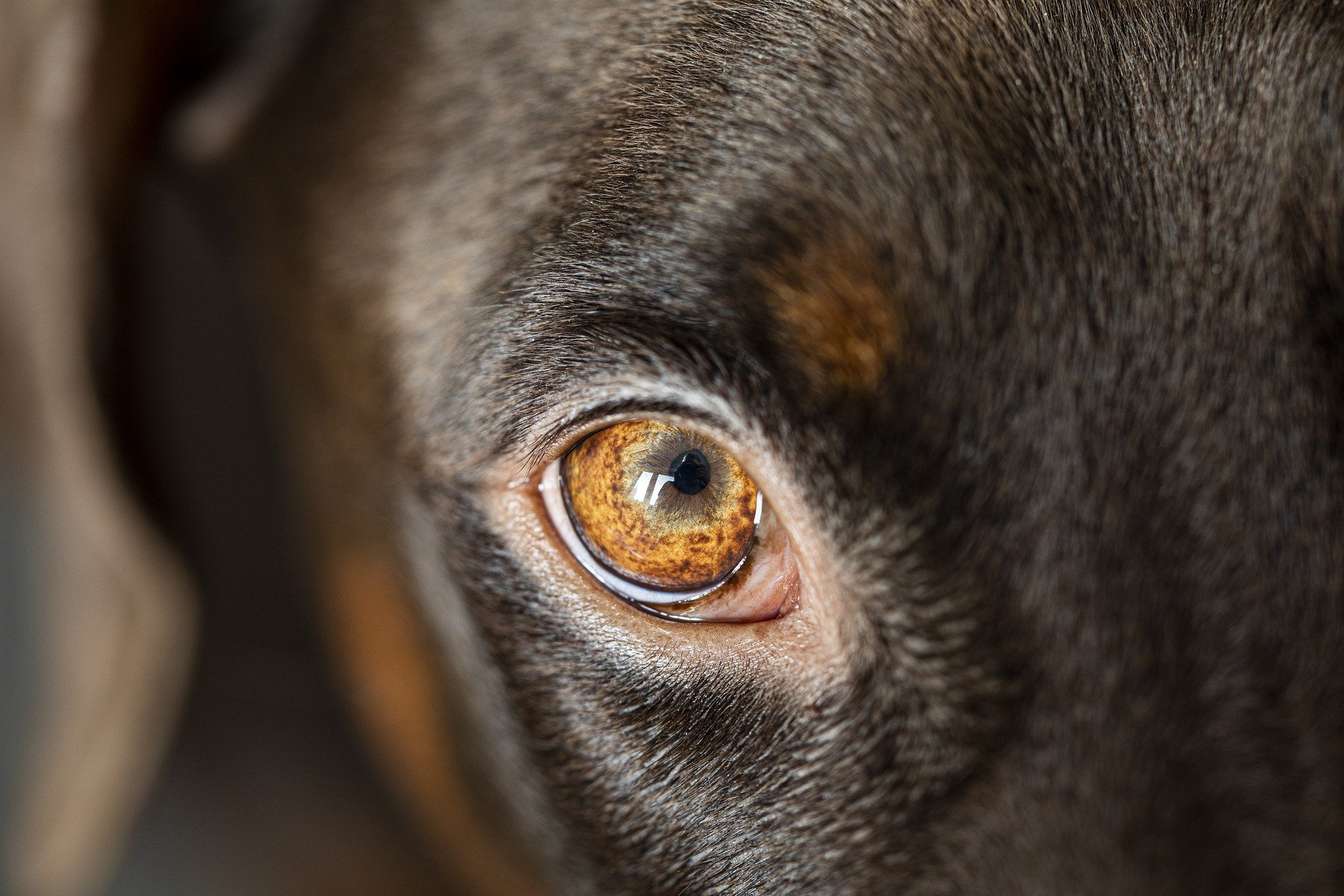Glaucoma in dogs
Glaucoma in dogs is a particularly serious eye disorder, which can lead to sudden blindness and even loss of the eyeball.
This pathology causes a lot of suffering, and it is therefore essential to know how to recognize it early on, in order to have it treated as soon as possible. Today, I propose you to look at the symptoms of glaucoma in dogs, its causes, its consequences and its health prognosis.
What is dog glaucoma?
In summary, dog glaucoma could be defined as an eye disease, but in fact, the term glaucoma refers to a syndrome, that is to say a set of symptoms resulting from multiple phenomena.
Glaucoma occurs when various eye conditions cause an increase in eye pressure that damages the optic nerve and retinal cells.
The eye as a whole suffers from this increased pressure, but the optic nerve, which transmits the signals captured by the retina to the brain in order to interpret them into images (which produces the sense of vision), is particularly sensitive.
In fact, glaucoma can quickly cause sudden blindness, sometimes irreversible. This phenomenon distinguishes dog glaucoma, which is generally acute, from human glaucoma, which often progresses slowly and therefore takes on a more chronic form. Glaucoma is a true veterinary emergency, as early treatment is essential to preserve the visual function of the dog.
If left untreated, complete loss of vision in the affected eye is almost inevitable within 48 hours. In addition, glaucoma can be extremely painful for the dog. Misdiagnosis - unfortunately quite frequent - and too late treatment often lead to the total loss of the eye.

Causes
There are different types of glaucoma in dogs, each with different causes. There are congenital glaucomas, hereditary glaucomas and acquired glaucomas.
Congenital glaucoma in dogs
Congenital glaucoma is a form of ocular defect that is present in puppies from birth. It is a relatively rare condition in our four-legged friends. The congenital form of this condition occurs as a result of severe abnormalities in the development of the eye during the fetal stage. However, the visible symptoms of glaucoma, especially buphthalmia, the swelling of the eye, are not visible until the puppy is three to six months old.
Hereditary primary glaucoma in dogs
A distinction is made between hereditary and congenital glaucoma in dogs. For cause, if the congenital glaucomas are often hereditary, the hereditary glaucomas are not systematically congenital, far from there. As a reminder, a hereditary disease is one that is passed on by the parents, while a congenital disease is one that is present at birth - two conditions that may appear to be related, but are not always so. Hereditary glaucoma in dogs is called primary, meaning that it occurs on its own and is not caused by any other underlying condition.
Dogs with hereditary glaucoma are born with a defect in the structure of the eye that predisposes them to develop the condition as adults. Not all dogs with this defect will develop glaucoma as adults, and the puppy's eyes are healthy at birth. The structural defects involved do not allow the aqueous humor, the liquid contained in the eye, to flow properly. This liquid accumulates inside the eyeball, causing excess pressure.
Hereditary glaucoma in dogs is always bilateral, but it is rare that both eyes are affected by the disease at the same time - several years may separate the first eye from the second. Typically, the onset of hereditary glaucoma in dogs is particularly abrupt and results in blindness within a few days in the absence of effective treatment. Some breeds are considered more at risk, such as the American Cocker Spaniel, Basset Hound, Boston Terrier, Chow-Chow and Shar Pei.
Finally, there is a particular form of hereditary glaucoma, which is mainly found in the Cairn Terrier. It is the melanocytic glaucoma of the Cairn Terrier, a disorder corresponding to the infiltration of melanocytes (cells pigmenting the skin) in the various tissues of the eye and the sclera. Although they do not degenerate into malignant tumors, these pigmented cells progressively colonize the structures of the eye, until they prevent the aqueous humor from being properly evacuated, which fatally leads to an increase in ocular pressure.
Secondary glaucoma in dogs
A disorder is said to be secondary when it occurs as a consequence of a primary disease. In the case of secondary glaucoma, cataracts, lens dislocation, intraocular tumors, retinal detachment, or uveitis are all underlying conditions that may be involved. Trauma (shocks, scratches, wounds, etc.) or the aftermath of eye surgery can also be complicated by secondary glaucoma. Secondary glaucoma is frequently unilateral, but it can also be bilateral when the primary lesion involves both eyes of the dog.
Symptoms
In most cases, glaucoma manifests itself as an acute, particularly brutal attack. As a result, it is extremely painful for the dog, and the owner may observe a great deal of discomfort in his companion. The dog tends to keep its eye partially or completely closed, to blink more often and to water.
The eye may be visibly red, and a white or bluish sheen may be seen on the surface of the cornea. The dog's general condition may deteriorate rapidly, with depression, stress, lack of appetite and all the signs of distress.
However, it is important to note that intense symptoms of glaucoma usually occur when it is too late, when the pressure in the dog's eye is already very high. To prevent your dog from suffering unnecessarily or even losing his sight, it is therefore essential to check his eyes regularly to detect any abnormality early, even if it is particularly discreet.
In the case of melanocytic glaucoma of the Cairn Terrier, the master can sometimes see light grey spots on the sclera of the eye (white part of the eyeball) before the disease appears.

Treatment and prognosis
If your dog has glaucoma, it is essential that you take him to a veterinarian as soon as possible, both to relieve the severe pain he is experiencing and to try to save his vision. Indeed, only an early and effective treatment will be able to prevent your dog from losing his sight permanently.
In most cases, treatment of glaucoma in dogs requires a combination of medical and surgical therapies. The preferred drug treatment will depend on the stage of the disease, any underlying conditions that may be involved and the pet's profile.
It is important to note that while secondary glaucoma can sometimes be permanently cured by treating the cause of the problem, this is not the case for hereditary primary glaucoma. Treatment will therefore be aimed at preserving visual function as best as possible - when possible - and increasing the pet's quality of life by avoiding pain.
In order to do this, the dog will usually have to be treated for life in order to maintain its intraocular pressure at a normal level. Daily administration of an eye drop that either decreases the production of aqueous humor or promotes its outflow - or a combination of both - is currently the traditional long-term treatment for canine glaucoma.
However, due to the fact that it is very demanding for the owner (it is impossible to miss a single administration of eye drops), surgery is generally preferred. A diode laser treatment or the implantation of a gognio implant (artificial drainage valve) can be considered, but complications are frequent. Also, surgical enucleation is frequently performed to end the problem.
The prognosis of a dog with glaucoma is poor. The dog's life is not necessarily in danger, but its visual function is usually compromised. In fact, existing drug treatments are restrictive, and palliative surgeries are not without complications and do not always offer satisfactory results.
In general, most therapies used to treat glaucoma can only preserve vision for a few months or even years, but surgical enucleation is almost always unavoidable. Although this alternative may seem drastic, it is important to note that a dog generally adapts very well to the loss of vision, which is not a highly developed sense in this species.
The dog's fantastic sense of hearing and smell compensate brilliantly for its blindness, and the animal can regain a very good quality of life by finally being rid of the overwhelming pain caused by its glaucoma. However, more attention should be paid to the blind dog to avoid putting himself in danger: remember that he cannot see cars coming, and that he should never swim away from his master, because in water he cannot use his sense of smell to find the shore.
FAQ
How do I know if my dog has glaucoma?
Dog glaucoma causes severe pain, and it is usually possible to see that the dog's eye is red and watery, and sometimes covered with a white or bluish veil. The dog may also hold its eyelid completely or partially closed, and appear downcast, sad, and in pain.
Can dog glaucoma be cured?
In most cases, canine glaucoma cannot be cured, but it can be controlled over time with a combination of medical and surgical treatments. The prognosis for the dog's visual function is poor, and surgical enucleation is often necessary in the long term.
My dog has glaucoma, what should I do?
If you suspect that your dog has glaucoma, it is essential that you visit a veterinarian as soon as possible. This condition is extremely painful and your dog may lose his sight if it is not treated early. Also, glaucoma is not a temporary condition. The pain will not go away on its own, and your dog's eye will not regain its functionality without treatment.
My dog has glaucoma, is it serious?
Yes, glaucoma in dogs is a particularly serious eye disease, which causes great suffering and inevitably leads to blindness if not treated early. Even when treated, glaucoma always jeopardizes the dog's visual function. Rather than preserving the sense of vision, which is not very well developed in our four-legged friends, the treatment will therefore consist mainly of relieving the violent pain caused by this condition.
Glaucoma in dogs is a serious disease, which unfortunately often leads to blindness. Indeed, the veterinary treatments currently indicated to control the disease are often expensive and restrictive, which pushes the owners to prefer, in the long run, a surgical removal of the sick eye.
However, just because your dog's visual function is often condemned when he suffers from glaucoma, there is no point in having him treated.
Glaucoma is, in fact, extremely painful. It is therefore essential to take your dog to a veterinarian to relieve his suffering, even if it means saying goodbye to his eye.


